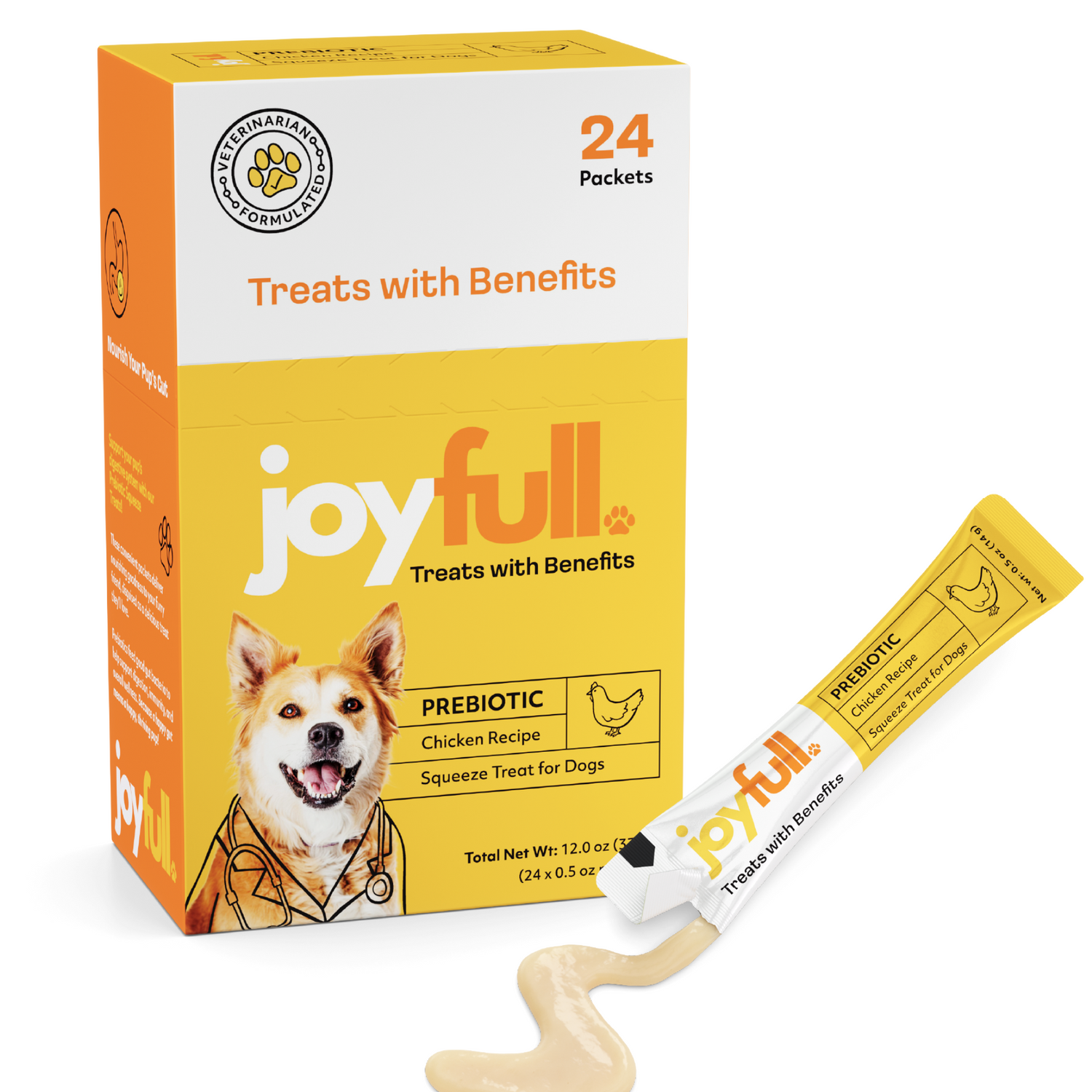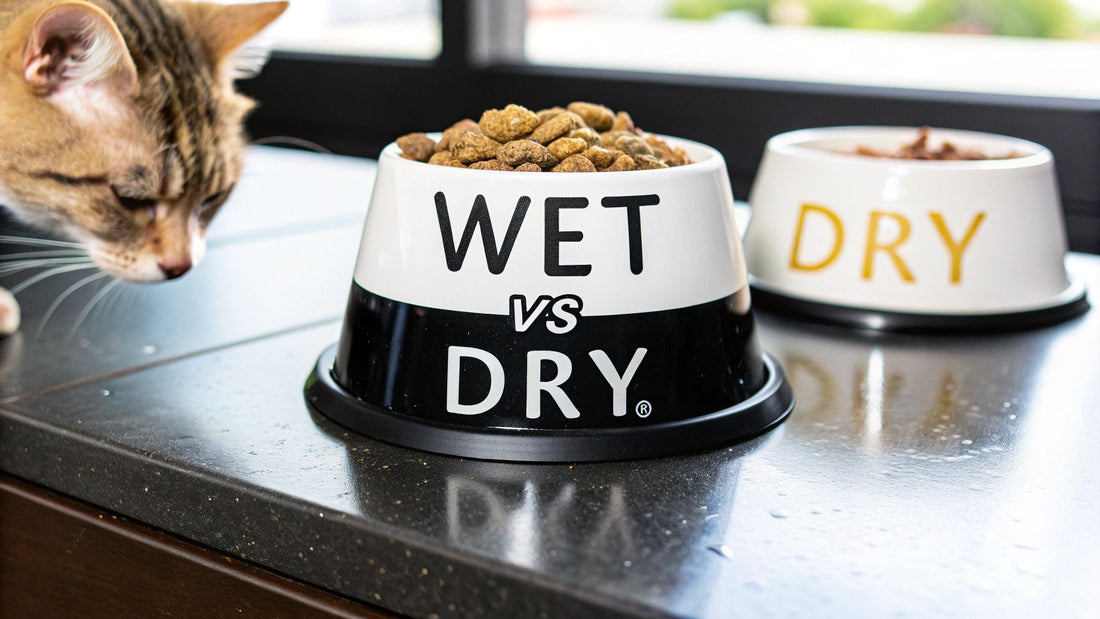
Wet vs Dry Cat Food Which Is Better for Your Cat
The endless wet vs dry cat food debate doesn't have a single winner. The best food for your cat comes down to their specific health needs, age, and even their lifestyle. For some cats, the high moisture content in wet food is a lifesaver. For others, the convenience and dental benefits of kibble are a perfect fit. It’s all about finding the right balance for your unique feline friend.
A First Look at Feline Food Choices
Walking down the pet food aisle can be dizzying. The real differences between wet and dry food go way beyond just texture and taste; they boil down to major variations in moisture, calorie concentration, and how they're made. Getting past the marketing myths is the first step toward making a great choice for your cat's health.
This guide will help you sort through the options. We'll break down what makes each food type tick so you have a solid, practical understanding of what you're actually feeding your cat.
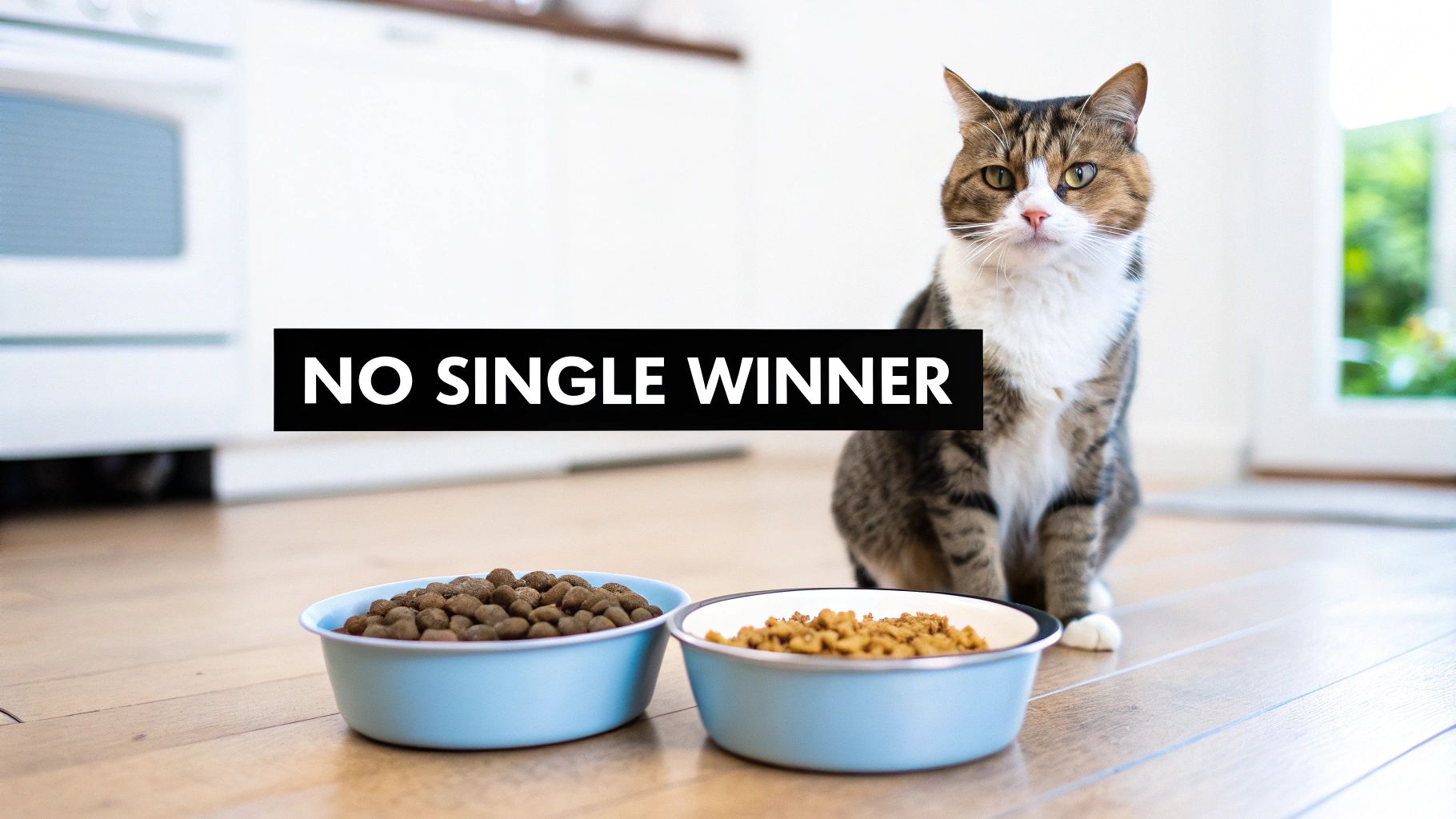
Key Distinctions Side-by-Side
To get us started, here’s a quick-reference table that lays out the core differences between wet and dry cat food. Think of this as a cheat sheet before we dive deeper into what these distinctions mean for your cat.
| Feature | Wet Cat Food | Dry Cat Food |
|---|---|---|
| Moisture Content | High (70-80%) | Low (9-12%) |
| Caloric Density | Lower per serving | Higher per serving |
| Shelf Life (Opened) | Short (refrigerate immediately) | Long (easy to store) |
| Palatability | Often irresistible to picky cats | The crunch is a big draw |
| Cost | More expensive per calorie | More budget-friendly |
Understanding Your Cat's Nutritional Blueprint
Before we can even begin to compare wet and dry food, we have to start with the cat itself. What makes a cat, a cat? It all comes down to one critical term: obligate carnivore. This isn't just a fancy label; it's the biological roadmap that dictates everything they need to thrive.
Unlike us or even our dogs, cats are built to run on a diet made almost entirely of animal-based protein and fat. Their systems are fine-tuned to pull specific nutrients, like the amino acid taurine, directly from meat. Without enough taurine from animal sources, cats can develop devastating health issues, from heart failure to blindness.
Protein: The Foundation of Feline Health
For a cat, high-quality animal protein is everything. It’s the fuel for strong muscles, healthy organs, and even a shiny coat. When you're scanning a food label, don't just look at the protein percentage; look at where it comes from. You want to see real meat, like chicken, fish, or beef, right at the top of the ingredient list. If you want to get really granular on this, our guide on choosing cat food with high protein is a great place to start.
Think about a cat's natural diet in the wild. A mouse or a small bird is about 70% water. This is a huge clue to their biology—cats evolved to get the majority of their hydration from their food, which is why they have such a low thirst drive.
Why Hydration is a Game-Changer
That naturally low thirst drive is at the heart of the wet versus dry food debate. Most domestic cats simply won't drink enough water from a bowl to make up for a diet of dry kibble alone.
This is a big deal, because proper hydration is absolutely essential for:
- Kidney Function: Good water intake helps the kidneys do their job of flushing out toxins, preventing them from being overworked over time.
- Urinary Tract Health: Keeping urine diluted is the best defense against the painful (and dangerous) formation of crystals and stones.
So, the moisture content of your cat's food isn't a minor detail—it's a massive factor in their long-term health. Keep this in mind as we dive into the specific pros and cons of canned food and kibble.
A Head-to-Head Comparison of Wet and Dry Food
Choosing the right food for your cat isn't just about picking a flavor they like. When you get down to it, the debate between wet and dry food involves a close look at what really matters for their health and what works for your life. Let's break down how they stack up in the areas that count the most.
This infographic gives a great visual overview of the core nutritional elements—protein, taurine, and hydration—that are absolutely fundamental to a cat's health.
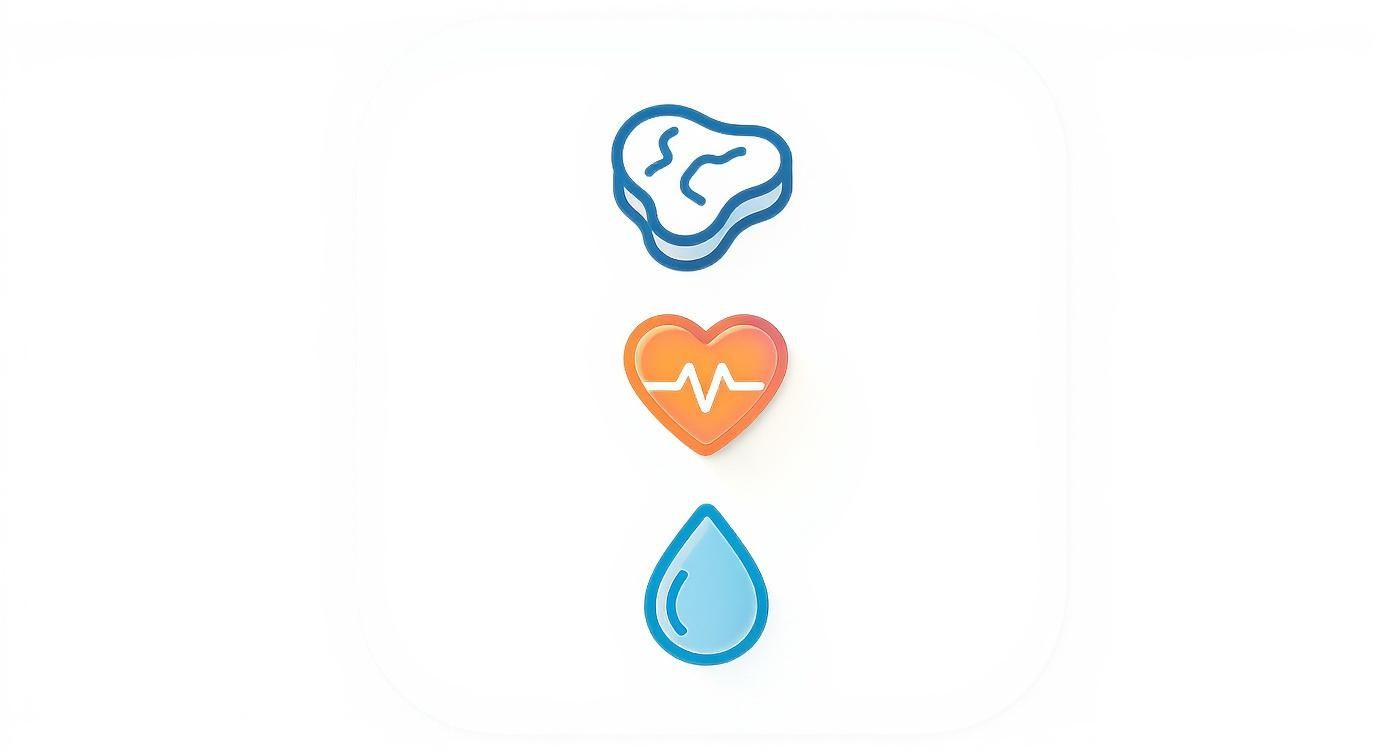
As you can see, hydration is a massive point of difference, and it’s a direct result of the food's format.
Hydration and Urinary Health
The biggest, most impactful difference between wet and dry food is simply water. Wet food is typically 70-80% moisture, which is a huge advantage. This high water content closely mimics the prey cats would eat in the wild and is a game-changer for cats that just don't drink enough on their own.
Dry kibble, on the other hand, contains only about 9-12% moisture. This means a cat on an exclusively dry diet needs to make a serious effort at the water bowl to stay properly hydrated, a task many cats frankly aren't up for.
Key Takeaway: For any cat with a history of urinary issues or one that you know is a poor drinker, the moisture in wet food isn't just a perk—it's a critical health benefit. It's hands-down the better choice for promoting a healthy urinary system.
Nutrient Profiles and Caloric Density
If you just glance at the label, dry food often looks like it has more protein. But that’s a bit misleading because of the low water content. When you compare them on a dry matter basis (which is how nutritionists look at it, with all the water removed), the protein levels in high-quality wet and dry foods are often quite similar.
The real nutritional differentiator is often the carbohydrate content. To make kibble, you need starches to bind it all together, which means most dry foods have a higher percentage of carbs. Wet foods, by their nature, can be made with fewer carbs and more animal-based protein, aligning much better with the needs of an obligate carnivore.
To help you see the differences clearly, here's a side-by-side breakdown.
Wet vs Dry Cat Food At-a-Glance Comparison
This table offers a detailed look at how wet and dry cat food compare across key nutritional and practical attributes, helping you make a more informed decision for your feline friend.
| Attribute | Wet Cat Food | Dry Cat Food |
|---|---|---|
| Moisture Content | 70-80% - Excellent for hydration and urinary health. | 9-12% - Requires cat to drink significant extra water. |
| Protein & Carbs | Generally higher in animal protein, lower in carbs. | Often higher in carbs due to binders; protein varies. |
| Caloric Density | Lower density; cats can eat more for the same calories. | Higher density; easy to overfeed, better for free-feeding. |
| Palatability | High; strong aroma and soft texture appeal to picky eaters. | Varies; many cats like the crunch, but less enticing for some. |
| Dental Health | Minimal effect; does not scrape teeth clean. | Can offer a minor abrasive benefit to help reduce plaque. |
| Cost | More expensive per calorie. | More budget-friendly and cost-effective. |
| Convenience | Requires refrigeration after opening; shorter shelf life. | Very convenient; long shelf life and suitable for free-feeding. |
| Storage | Must be used within a few days of opening. | Easy to store in an airtight container for weeks. |
Ultimately, this table highlights the trade-offs: wet food excels in hydration and species-appropriate nutrition, while dry food wins on convenience and cost.
Palatability for Picky Eaters
When it comes to pleasing a finicky cat, wet food is usually the undisputed champion. Its rich aroma and soft, meaty texture are incredibly appealing. This makes it a fantastic choice for older cats, those with dental problems, or any cat whose appetite is a bit off.
While plenty of cats enjoy the crunch of kibble, a picky eater is far more likely to snub a bowl of dry food than a serving of savory canned pâté or gravy.
Convenience, Cost, and Storage
This is where dry food really has the edge. It’s significantly more affordable, especially when you break it down per calorie. Plus, it has a long shelf life and can be left out for cats who prefer to graze, a practice known as "free feeding." The convenience factor is a big reason why dry food commands over 40% of the global pet food market.
Wet food, in contrast, is pricier and demands a bit more effort. Once you open a can, it needs to be covered and refrigerated, and it won't last more than a couple of days. This is an important part of learning how to store pet food properly to keep it safe and fresh for your cat.
How Each Food Type Impacts Feline Health
https://www.youtube.com/embed/6cvxA1CMbMQ
When you're standing in the pet food aisle, it’s easy to get lost in the marketing. But the choice between wet and dry food isn't just about taste or convenience—it has a direct and measurable impact on your cat's long-term health.
For cats with specific health issues, the right food can be less of a meal and more like medicine. This is especially true when it comes to one of the most fundamental needs: hydration.
Urinary Tract and Kidney Support
The biggest win for wet food, hands down, is its moisture content. Most canned foods are around 75-80% water, which is a massive advantage for cats prone to urinary tract problems or living with chronic kidney disease (CKD).
That extra water intake helps to dilute their urine, making it much harder for painful urinary crystals and stones to form. And for a cat whose kidneys are already struggling, staying well-hydrated is absolutely essential for flushing out toxins.
It's a common belief that if a cat is drinking from their water bowl, they're fine. The truth is, cats have a very low thirst drive. Many cats fed an exclusively dry diet live in a state of mild, chronic dehydration without their owners ever realizing it.
The Myth of Dental Cleaning
You’ve probably heard it a dozen times: "Dry food cleans your cat's teeth." The idea is that the hard kibble scrapes away plaque as they chew. It sounds plausible, but for the most part, it's a myth.
Sure, a few highly specialized dental formulas might provide a tiny bit of abrasive action. But with standard kibble? Most cats either swallow it whole or just crack it once, meaning it barely touches their teeth. It's definitely not a replacement for proper dental care like brushing. Relying on kibble for clean teeth gives a false sense of security while dental issues could be silently getting worse.
Weight Management and Satiety
Obesity is a serious problem for indoor cats, often leading to diabetes and painful joint issues. This is an area where wet and dry foods really part ways. Wet food is much less dense in calories, so your cat can enjoy a bigger, more satisfying meal without overdoing it. That feeling of fullness can make all the difference in preventing constant begging.
On the flip side, dry food packs a lot of energy into a small package, which means portion control has to be exact. Just a handful of extra kibble each day can easily lead to weight gain. Beyond what they eat, how they eat matters, too. For fast eaters, you might want to look into specialized feeding tools like slow feeders to improve digestion and provide a bit of mental enrichment.
Choosing the Right Food for Your Cat’s Life Stage
A cat’s nutritional needs aren't static; they evolve dramatically from their whirlwind kitten phase to their more serene senior years. The whole wet vs. dry cat food discussion is less about a simple preference and more about strategically matching their diet to their life stage for peak health.
Think about your cat’s age, how much they zoom around the house, and any health quirks they might have. These are the biggest clues you have. What fuels a high-energy kitten just won't cut it for a napping-champion senior.
Kittens: Fueling the Growth Spurt
Kittens are little dynamos, and they need calorie-packed food to build strong bones and muscles. You can find both wet and dry foods formulated for them, but each brings something different to the table.
- Wet Food: Its soft consistency is a lifesaver for tiny teeth and jaws. Plus, it’s a great way to sneak in extra hydration, which is always a bonus.
- Dry Food: Good quality kitten kibble is loaded with the energy they need. The big advantage here is that you can leave it out for them to "graze," which suits their small tummies and need for frequent, tiny meals.
Adult Cats: Striking a Healthy Balance
Once your cat hits their adult years—usually between one and seven—the focus pivots from rapid growth to simply maintaining a healthy, stable condition. This is when portion control really starts to matter, as it's all too easy for them to pack on extra pounds.
The best choice often comes down to their lifestyle. A chill indoor cat who prefers lounging over leaping might do better with the lower calorie count in wet food to keep their weight in check. On the flip side, a more active cat can thrive on the convenience of a carefully measured dry food diet. For a more detailed breakdown, our complete guide on how to choose cat food has you covered.
Seniors: Giving Them Extra Support
As cats step into their golden years, their dietary needs shift yet again. It's common for senior cats to have a lower thirst drive, more sensitive teeth, and a metabolism that’s slowed down a bit.
For senior felines, wet food is often the superior choice. Its high moisture content supports aging kidneys, and the soft texture is much gentler on sensitive teeth and gums, ensuring they can eat comfortably.
The Benefits of a Mixed Feeding Strategy
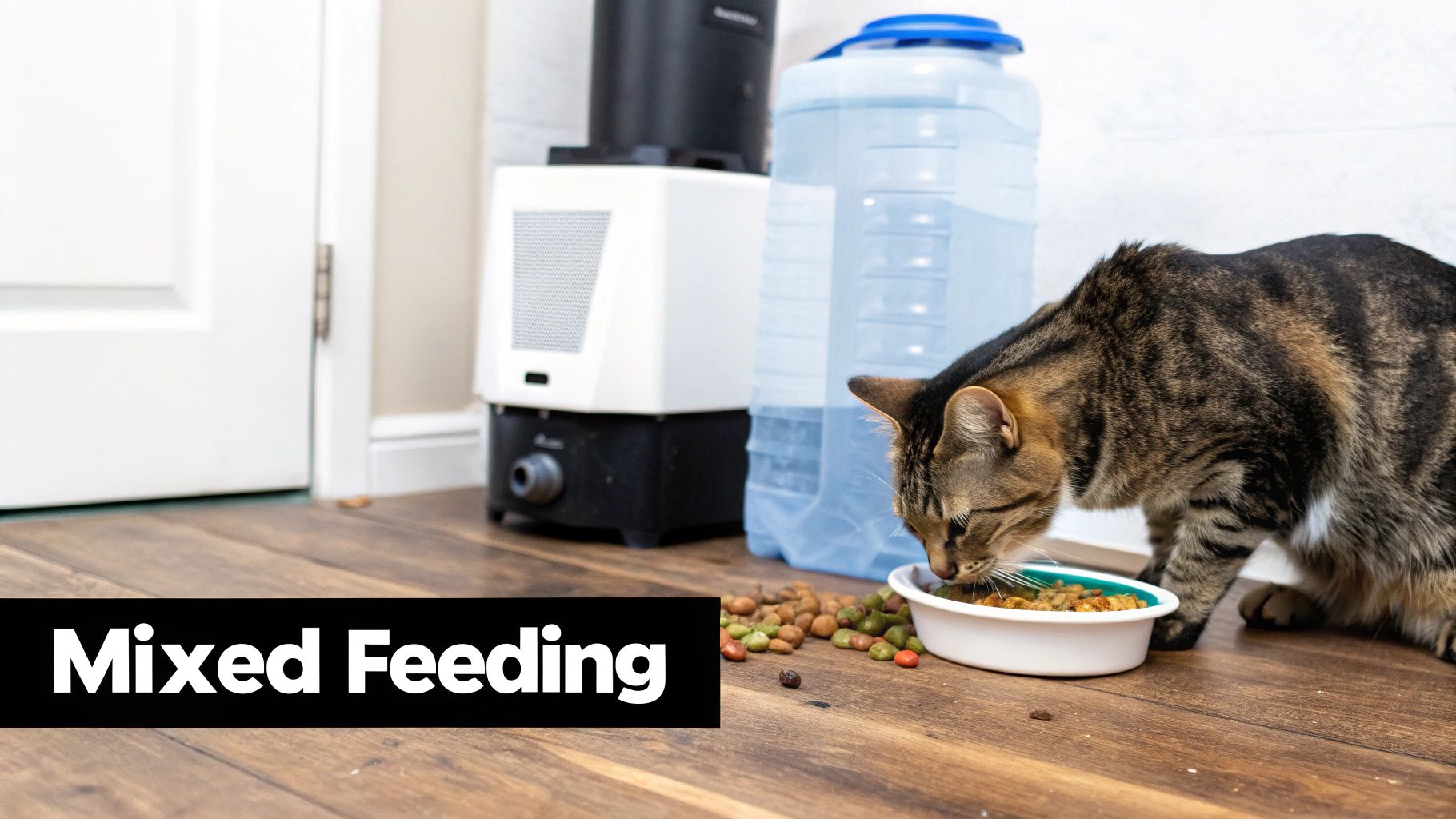
The whole wet vs. dry cat food debate doesn't have to be a black-and-white choice. In fact, many vets and long-time cat owners advocate for a middle-of-the-road approach: mixed feeding. This simply means combining both types of food to give your cat the best of both worlds. It's a practical and balanced solution that fits well for a lot of cats and their owners.
When you offer both, your cat gets the fantastic hydration and rich flavor of wet food alongside the convenience and budget-friendliness of kibble. A really common way to do this is to serve wet food once or twice a day as a special meal, while leaving a carefully measured amount of dry food out for them to graze on throughout the day.
How to Implement a Mixed Diet
Switching to a mixed diet isn't complicated, but you do need to be thoughtful to prevent an upset stomach or accidental weight gain. The secret is to go slow and keep a close eye on your cat's total daily calories.
First, figure out your cat's daily caloric needs based on their age, weight, and activity level. From there, you can decide on the ratio. For instance, you could aim for 50% of their calories from wet food and the other 50% from dry food.
A great way to start is by swapping out just a small part of their daily kibble with a spoonful of wet food. This lets their digestive system get used to the new food gradually while immediately boosting their moisture intake.
Consistency really helps when you're making this change. Try to serve the wet food portion at the same time every day. Cats are creatures of habit, and a predictable routine helps them look forward to mealtime, making it a positive and stress-free part of their day. Ultimately, this flexible feeding strategy can give your cat a more satisfying and varied diet.
Common Questions About Wet vs. Dry Cat Food
Choosing the right food can feel complicated, but it doesn't have to be. Let's tackle some of the most frequent questions cat owners ask when deciding between wet and dry options.
How Long Can I Leave Wet Cat Food Out?
This is a big one. You should never leave wet food out for more than an hour or two at most. In a warm room, that time frame gets even shorter. The high moisture content that makes it so good for hydration also makes it a perfect breeding ground for bacteria, which can make your cat sick.
The best practice is to serve wet food at designated mealtimes. Once your cat is finished, pop any leftovers into an airtight container and straight into the fridge. This keeps every meal as fresh and safe as the first.
Is One Type of Food Better for Weight Management?
Absolutely. Wet food is typically the winner when it comes to managing your cat's weight. Because of its high water content, it helps your cat feel full and satisfied on fewer calories. This means they can often enjoy a more generous-sized meal of wet food for the same calorie count as a small scoop of kibble.
Dry food, on the other hand, is much more calorie-dense. A few extra pieces here and there can quickly lead to weight gain, so you have to be incredibly precise with your portion control.
For cats who need to watch their weight, the lower calorie density of wet food is a game-changer. It allows for a more satisfying meal, which can cut down on begging and help your cat maintain a healthier body condition over the long term.
What's the Right Way to Switch My Cat to a New Food?
The key here is to go slow. A gradual transition over 7-10 days is crucial for preventing an upset stomach. Switching food too quickly is a common cause of vomiting or diarrhea, and nobody wants that.
Here’s the simple method:
- Start by mixing just a little of the new food (about 25%) with their old food (75%).
- Every couple of days, slightly increase the amount of new food and decrease the amount of the old.
- Continue this gentle process until you’ve fully switched over.
At Joyfull, we believe your cat deserves food made with clean ingredients and high-quality proteins. Discover our formulas designed for a healthful life.
